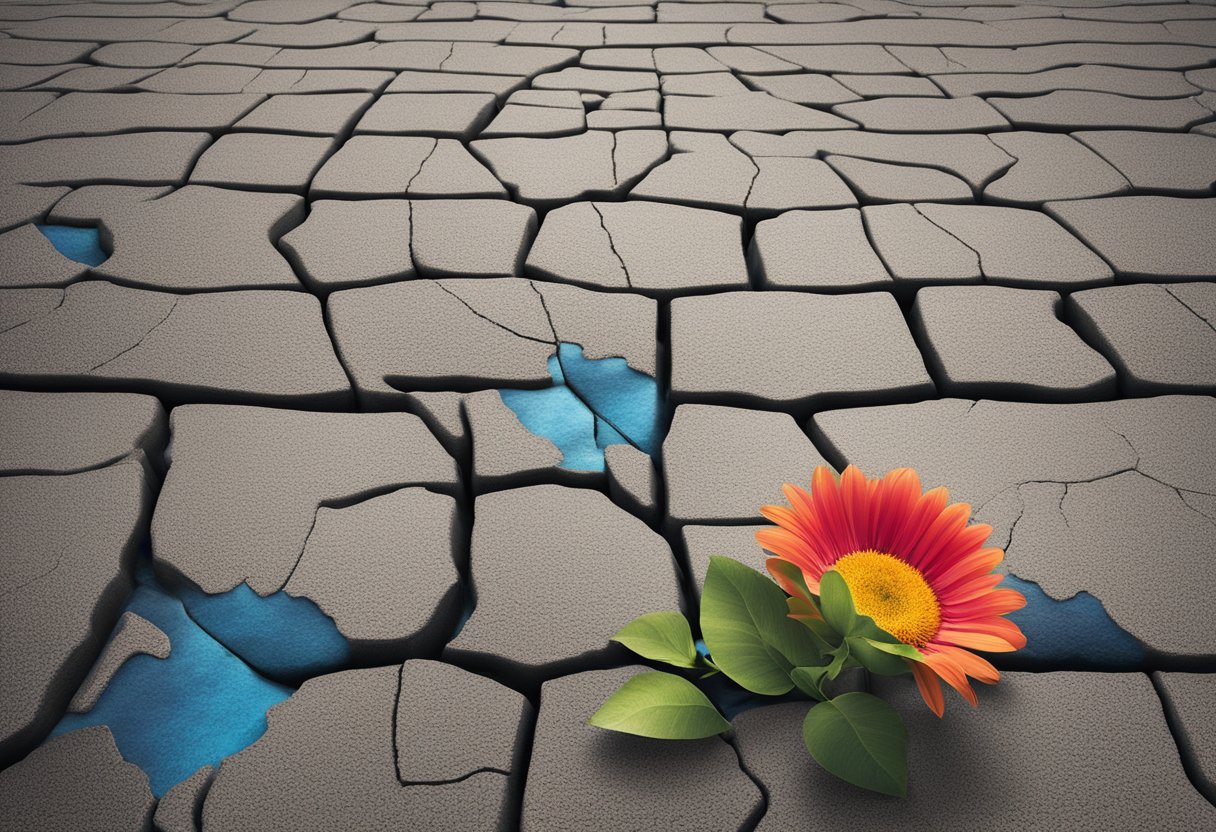Cancer Thriver’s Journey to Empowerment
Resilience and hope are not just abstract concepts. They become the bedrock for those who’ve faced the adversity of a cancer diagnosis.
As a two-time lymphoma survivor, I can vouch for their transformative power. Your journey through cancer can be a pathway to unexpected personal growth and a newfound appreciation for life.
These values enable us to confront the most challenging moments and develop a stronger sense of self.

As you navigate this journey, remember that resilience is a wellspring that nourishes your spirit and propels you forward.
It’s about more than just enduring; it’s about thriving and embracing each day with vigor. On the other hand, hope is the compass that guides you through uncertainty.
It’s a force that ignites positivity and fuels the perseverance needed to continue the fight against cancer.
Key Takeaways
- Resilience transforms challenges into opportunities for personal growth.
- Hope acts as a steadfast guide through the trials of cancer.
- Thriving after cancer involves embracing each day with renewed strength and positivity.
Understanding Cancer
Navigating a cancer diagnosis demands clarity and knowledge. Equip yourself to understand the complexities of cancer, including its types and stages, and the modern treatment options available.
The Cancer Diagnosis
When you hear “You have cancer,” the world may seem to pause. Cancer is a disease where cells in your body grow uncontrollably and spread to various parts.
A diagnosis starts with a physical exam, lab tests, and scans. If lymphoma, a cancer of the lymphatic system, is suspected, a biopsy might be necessary to confirm the presence of cancerous cells.
Types and Stages of Cancer
Cancer isn’t a singular entity but a collection of diseases, each with its subtypes, such as lymphoma, which itself is classified into Hodgkin and non-Hodgkin types.
Oncologists categorize cancer into stages I to IV based on size, location, and spread, informing treatment options and offering insights into prognosis.
- Stage I: The cancer is small and contained within the organ it started in.
- Stage II: The cancer has grown, but it hasn’t spread.
- Stage III: The cancer is more extensive and may have spread to the surrounding tissues and the lymph nodes.
- Stage IV: The cancer has spread to other organs or parts of the body.
Modern Cancer Treatments
Treatment plans are tailored to your specific cancer type and stage upon diagnosis.
Chemotherapy, which uses potent drugs to kill cancer cells, remains a cornerstone of cancer treatment.
Technological advancements now offer more sophisticated and targeted therapy options designed to attack cancer cells while minimizing damage to healthy tissues.
Here are some treatments you might encounter:
- Chemotherapy: Used to shrink or kill cancer cells, often preparing you for other procedures or used after surgery to destroy remaining cells.
- Radiation Therapy: High-energy particles or waves target the affected area, damaging the DNA of cancer cells.
- Targeted Therapy: Focuses on specific proteins that control how cancer cells grow and spread.
The Journey of Resilience
As a cancer survivor, understanding and embracing resilience can be a transformative aspect of your recovery and adaptation. Let’s explore how resilience plays a role in overcoming cancer’s challenges.
Trait Resilience and Cancer
Resilience is not just a buzzword but a robust trait influencing how you cope with cancer.
Think of trait resilience as your built-in capacity to rebound from stressors. It shapes your psychological hardiness and emotional response to your diagnosis.
Trait resilience is associated with many positive outcomes, such as reduced distress and improved quality of life.
If you find yourself naturally inclined to remain hopeful and maintain a positive outlook, this innate resilience aids your journey as a survivor.
Building Resilience during Cancer
Building resilience is like constructing a fortress against cancer’s upheaval. It’s about honing your coping strategies and mental fortitude.
Start by weaving a tight-knit support system of family and friends. Regular physical activity, even light exercises, can bolster your psychological resilience, weaving physical well-being into mental health.
Engage in activities that reinforce your sense of purpose and self-worth. Small wins in these activities can lend you strength and confidence to face your disease.
Remember, each step forward on this path fortifies your resilience.
Resilience Interventions
Evidence suggests that tailored interventions are essential for nurturing resilience.
These interventions should extend beyond medical treatment and offer psychological and emotional support.
Embrace programs that promote positivity and mastery over your situation, as they can improve adaptation post-diagnosis.
With the right interventions, you’re not just combating cancer but actively re-scripting your narrative as a thriver.
Each intervention you participate in is a building block in your journey, helping you emerge more resilient than before.
Mental Health and Cancer
Navigating through a cancer diagnosis and treatment can pose significant mental and emotional challenges. As someone who’s survived lymphoma cancer twice, the journey has taught me the immense value of resilience and mental fortitude, particularly for men who often find it challenging to express vulnerability.
Psychological Impact of Cancer
Cancer diagnoses often come with a heavy psychological burden. From the moment you hear “You have cancer,” a wave of fear and uncertainty crashes over you.
It’s not just a physical fight; it’s an emotional battle where your mental health requires just as much care as your body.
Resilience becomes your shield, hope, and spear as you face this adversary.
Depression and Anxiety in Cancer Patients
It’s not uncommon for feelings of depression and anxiety to surface. Reports suggest that up to 38% of cancer patients experience mental health challenges.
Indicators include persistent sadness, loss of interest in loved activities, and overwhelming anxiety disrupting daily life.
Your armor against these foes combines professional support, peer networks, and personal coping strategies that resonate with you.
Managing Emotional Distress
The path to managing emotional distress is as unique as your fingerprint.
Practical steps, like maintaining an active lifestyle through sports and engaging exercise, offer physical and mental health benefits.
Joining a support group to talk with fellow survivors can provide solace and camaraderie.
No matter how small, every victory is a triumph over cancer’s shadow, ushering in light and strength for the journey ahead.
Physical and Social Well-Being

In the aftermath of cancer treatment, your recovery path hinges not just on physical healing but also on the robustness of your social network.
Physical Health Challenges
After enduring the rigorous treatments required to combat lymphoma, your body may still face significant health hurdles.
These physical challenges can range from persistent fatigue to vulnerability to infections. Sticking to a consistent exercise regimen and a balanced diet becomes crucial to boosting your physical well-being and improving your quality of life.
Regular movements, be it a brisk walk or engagement in light sports, can fortify your system against relapses and aid in smoother recovery.
Social Support Systems
Navigating the complexities of cancer recovery demands more than solitary resilience. A strong social support system—comprising family, friends, and fellow survivors—plays a pivotal role.
These networks can offer practical aid and emotional sustenance, directly influencing your coping ability.
For male survivors, finding support groups with shared experiences can be instrumental in fostering a sense of camaraderie and understanding, proving essential for grappling with your new reality.
Lifestyle and Recovery
Your lifestyle post-cancer should center on choices that underpin recovery.
This takes shape through dietary adjustments to incorporate nutrient-rich foods, adequate rest to allow your body to heal, and elimination of harmful habits such as tobacco or excessive alcohol use.
Moreover, diving into sports can provide a structured, community-driven avenue for physical activity that harmonizes your mental and physical health—a balanced lifestyle is the keystone of your journey back to vitality.
Spirituality and Coping

In navigating the aftermath of cancer, many individuals find solace and strength in spirituality, which offers diverse coping strategies and fosters spiritual well-being in challenging times.
The Role of Spirituality
Spirituality is a beacon of light during the darkest times of a cancer journey.
As someone who has faced lymphoma head-on twice, the depth of spiritual exploration cannot be overstated. The unshakeable belief in something greater carries you through the storm of stress and uncertainty.
As a man who has traversed this rugged terrain, spirituality might manifest in various forms—meditation, prayer, or a profound sense of connection with the universe.
These practices can be vital toolbox components, equipping you with coping strategies that transform desolation into resilience.
Spiritual WelWellbeingd Cancer Care
Spiritual well-being is a cornerstone in the edifice of cancer care, encompassing a sense of peace and purpose.
Clinicians at the Mayo Clinic assert that incorporating spirituality into care plans substantially aids in alleviating distress and enhancing quality of life.
Engaging in spiritual communities or discussions can provide a support network that resiliently buffers against the turmoil of your condition.
While attending to your physical needs is crucial, tending to your spiritual health is critical in creating a comprehensive, healing-focused environment.
Positivity and Post-Trauma Growth

After facing life’s sternest tests, harnessing a positive mindset can be transformative. This approach fuels your recovery journey and your evolution into a stronger, more centered self.
Harnessing Positive Psychology
Hope emerges as a beacon, guiding you beyond survival toward a future filled with possibilities.
Positive psychology, rooted in fostering mental well-being, offers you tools to rebuild and fortify your inner strength.
By setting positive expectancies for your recovery and beyond, you create a mental environment conducive to healing.
Embrace activities that reinforce this attitude — meditation, affirmations, and engaging in sports- can be powerful catalysts for maintaining a positive outlook.
Experiences of Post-Traumatic Growth
Surviving lymphoma not just once but twice carves a path to an understanding that extends beyond the self.
Such experiences lay the groundwork for post-traumatic growth, wherein you may find enriched personal relationships, a greater appreciation for life, and a surge in personal strength.
Men who’ve trodden this path report a profound shift in perspective, encouraging them to lead lives with purpose and passion.
Cancer thrivers often recount changes in their priorities and a newfound determination to live each day fully, rekindling interests, including sports, that may have been sidelined.
This growth isn’t a given; it requires reflection, support, and a heart open to change.
Survivorship and Beyond

After the arduous journey of cancer treatment, embracing a new normal sets the stage for a future paved with hope and resilience.
The quest does not end with remission; instead, a different chapter begins, one that demands attention and care, just as the treatment phase did.
Navigating Life after Cancer
As you step into life after cancer, you’ll find yourself on a path that requires careful negotiation between what once was and what lies ahead.
Your identity as a survivor is multifaceted, reflecting not just your medical history but personal triumphs.
Support networks are pivotal during this phase, as they provide a framework for growth and healing.
Activities tailored to your interests, such as sports, can serve as a solid foundation for rebuilding strength and enhancing your life satisfaction.
Information shared among communities, like insights from a study on resilience among cancer patients, offers a beacon of understanding for what affects post-treatment satisfaction.
Long-Term Survivorship Issues
Longevity brings its own set of concerns for cancer survivors.
You are tasked with managing your health, which now includes regular check-ups to monitor for recurrence and address any late effects of treatment.
The evidence of survivorship issues is evident in the ongoing research and resources, like the American Cancer Society’s survivorship guidelines, designed to address the nuances of living after cancer.
For men who have walked this road, the narrative is particularly unique, with societal expectations often impacting their approach to post-treatment life.
Engage in constructive dialogue, perhaps in sport-focused support groups, which can be a domain for men to relate and reclaim a sense of normalcy and camaraderie.
Final Thoughts

As you navigate the aftermath of lymphoma, embrace hope and resilience as your companions. Their presence can transform your path into one of survival and thriving.
Post-treatment life holds a new set of challenges, and it’s essential to gather support, seek relevant resources, and stay physically active, as these can serve as cornerstones for your ongoing wellness.
Cultivate Resilience:
- Recognize your strength drawn from past victories.
- Engage in community sports, leveraging camaraderie for healing.
- Set realistic goals to foster a sense of achievement.
Hope as Your Beacon:
- Hold on to positive expectations for the future.
- Cherish each day’s victories, no matter the scale.
- Use your experience to inspire and support fellow survivors.
Through your dual trials with cancer, you’ve amassed profound insight. Lean on that knowledge. Offer your hand to peers finding their footing. Advocate for men’s health initiatives in cancer, emphasizing early detection and proactive care.
Physical activity can also support your emotional well-being, especially in the context of team sports. This shared space offers mutual support, invigorates your spirit, and builds a sense of normalcy.
Always remember, you’re not alone in this. There is strength in numbers, and as a community, we are unyielding. Keep pushing forward, advocating for your health, and inspiring resilience in yourself and others. The road ahead is lined with hope—yours for the taking. -T
Frequently Asked Questions
Exploring questions commonly asked by cancer patients can provide insight and guidance on your path to resilience and hope.
How can hope and resilience affect the treatment outcomes for cancer patients?
Hope serves as a light guiding you through treatment, instilling a mindset that can positively influence recovery. Research suggests embracing resilience may improve your quality of life and potentially impact treatment outcomes.
What lifestyle choices can enhance resilience for those diagnosed with cancer?
Lifestyle choices that bolster physical health, like balanced nutrition and regular exercise, are crucial. Engaging in social activities and maintaining connections with others fosters emotional strength.
Which inspirational quotes provide the most comfort for cancer thrivers seeking hope?
Quotes like “You beat cancer by how you live, why you live and how you live,” by Stuart Scott, can resonate deeply with those facing cancer. Words carry power, fueling your spirit through the battle.
Are there any documented cases of survival from late-stage cancer that can offer hope?
Yes, narratives like Lance Armstrong’s triumph over stage three testicular cancer inspire many, proving that the unexpected is possible. Such stories can be powerful motivators.
What are the dietary considerations for hormone-positive breast cancer to remain resilient during treatment?
Adopt a diet low in fat and high in fruits, vegetables, and whole grains. Specific foods, like soy, may influence hormone levels, so tailor your diet to your unique health needs.
In what ways can the community support cancer patients to foster a sense of hope and care?
Community support can take many forms. It can be through organized events or personal gestures. Offering practical help, like rides to the clinic or meal preparation, can make a significant difference in someone’s healing journey.
